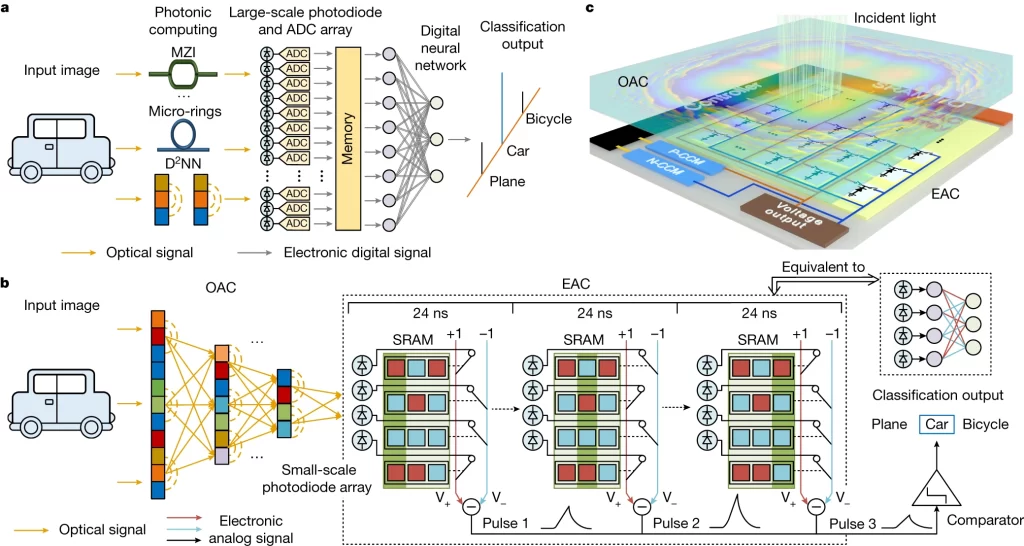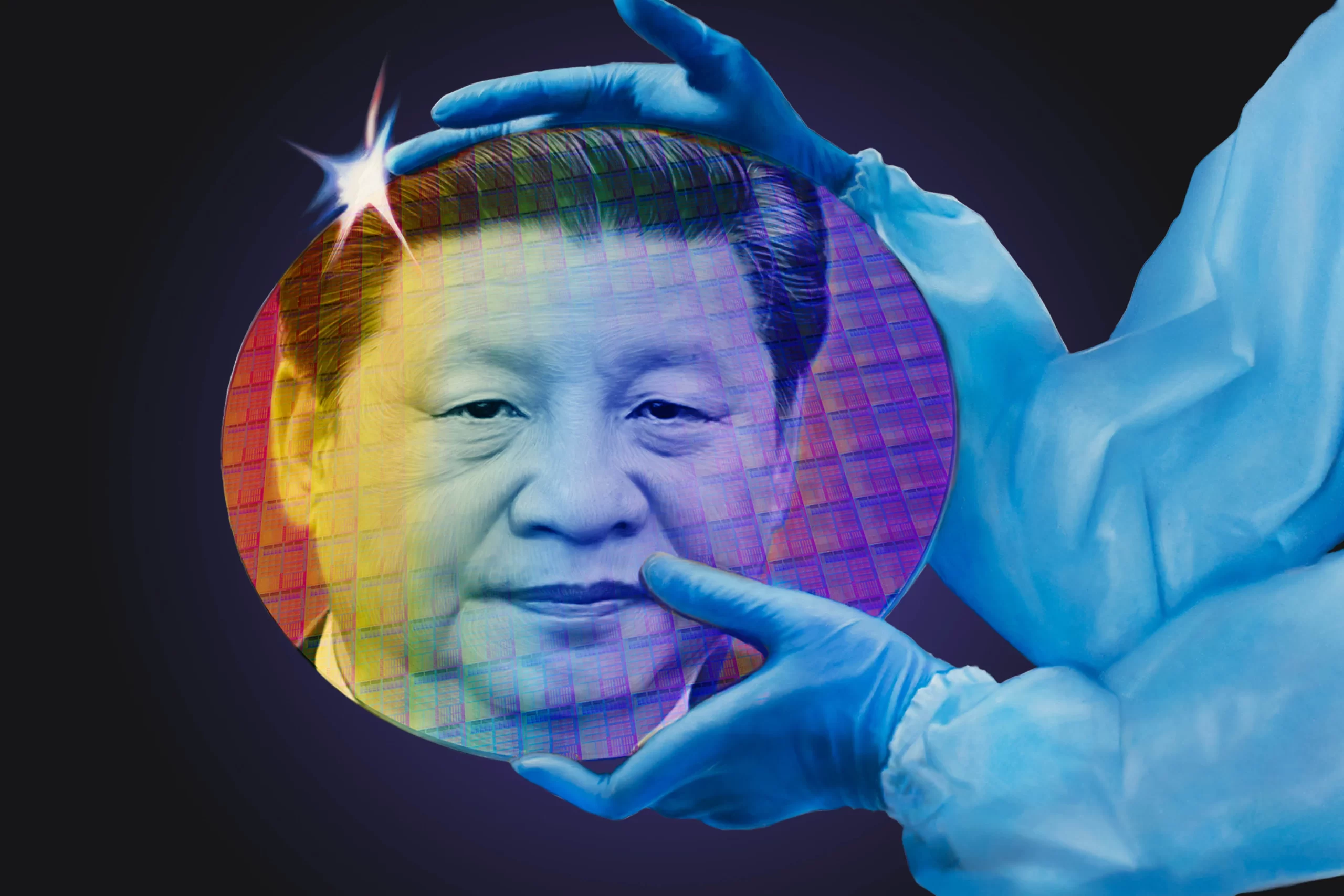Introduction
In a major breakthrough for the field of artificial intelligence (AI), scientists from China have recently introduced an extraordinary innovation – the All-Analogue Chip Combining Electronics and Light (ACCEL).
The ACCEL chip represents a revolutionary step in AI technology, leveraging the properties of photons for computing and information transmission.
During a lab experiment, the ACCEL chip demonstrated an impressive computing speed of 4.6 PFLOPS (peta-floating point operations per second), surpassing the speed of one of the most commonly used commercial AI chips, Nvidia’s A100, by a factor of 3,000.
Additionally, researchers noted that the Chinese chip’s energy consumption is a staggering 4 million times lower.
In this comprehensive blog post, we’ll explore the intricacies of this groundbreaking chip, its potential applications, and the profound impact it could have on the AI landscape.
“Deployment of photonic computing systems used to be a challenge due to complicated structural design and vulnerability to noise and system errors. The team innovatively introduced a computing framework that fuses photonic and analogue electronic computing,”
~Tsinghua’s website
The ACCEL Chip: A Paradigm Shift in AI Technology from China
Photon-Based Computing:
Unlike traditional AI chips that rely on electric current for calculations, the ACCEL chip harnesses photons, the fundamental particles of light, for computation and data transfer.
While the concept of light-based chips isn’t entirely novel, previous attempts were hindered by the challenges of controlling photons with precision.
Remarkable Speed:
Laboratory tests have showcased the ACCEL chip’s extraordinary computing capabilities, achieving an astounding computing speed of 4.6 peta-floating point operations per second (PFLOPS).
This remarkable speed eclipses one of the most popular commercial AI chips, Nvidia’s A100, by a factor of approximately 3,000.
Unprecedented Energy Efficiency:
The ACCEL chip isn’t just fast; it’s exceptionally energy-efficient. Researchers have found that it consumes a staggering four million times less energy compared to conventional AI chips, a characteristic that has the potential to reshape the energy dynamics of AI-driven applications.
Affordable Fabrication:
Unlike advanced AI chips such as Nvidia’s A100, which rely on sophisticated lithography machines that China lacks access to, the ACCEL chip was manufactured using a cost-effective 20-year-old transistor fabrication process(180 nm), thanks to China’s Semiconductor Manufacturing International Corporation (SMIC).
“The performance [of the chip] could be further optimised through improvements in the building process or by adopting more expensive fabrication processes under 100 nanometres,”
~Research team from Tsinghua University’s automation and electronic engineering departments wrote in the paper published last week.
Science behind ACCEL- AI chip from China
The science behind the ACCEL chip’s operation is rooted in the field of photonics, which is the study and manipulation of light and its properties for various applications, including computing. Here’s an explanation of how the ACCEL chip works:
Photon-Based Computing:
Instead of relying on traditional electronic circuits and transistors, the ACCEL chip uses photons, which are particles of light, to perform computations. This is a departure from the electrical current-based computing used in conventional chips.
Encoding Information in Photons:
Information in the ACCEL chip is encoded and processed using photons. Photons are advantageous for information processing because they are incredibly fast and can carry multiple pieces of data simultaneously, thanks to their high speed and the ability to be manipulated in various ways.
Photonic Circuits:
Within the chip, there are photonic circuits designed to manipulate and process photons. These circuits can perform operations like addition, subtraction, and other mathematical computations by using the characteristics of light, such as its wave nature.
Optical Components:
The chip includes various optical components like waveguides, which guide and direct the flow of photons, and modulators, which control the intensity or phase of the light, allowing for the execution of logical operations.
Interference and Superposition:
One of the principles applied in photonic computing is interference and superposition. Photons can interfere with each other, leading to constructive or destructive interference. This property enables the chip to perform complex computations efficiently.
Light Signals for Data Transmission:
The chip also uses photons for data transmission. Light signals carry information within the chip and between connected components, achieving high-speed communication and reducing latency.
Energy Efficiency:
Photons are energy-efficient because they don’t generate heat like electrical currents. This property results in a significant reduction in energy consumption, making the chip exceptionally energy-efficient.
Speed and Parallelism:
Photonic computing offers remarkable speed because photons move at the speed of light. Furthermore, they can be manipulated in parallel, which means multiple computations can occur simultaneously, contributing to the chip’s high processing speed.
Limitations and Specific Applications:
The ACCEL chip is specialized for specific tasks due to its analog computing architecture, making it less suitable for general computing, such as running multiple programs or file compression.
ACCEL chip utilizes photon properties to achieve incredible speed and energy efficiency, marking a significant advance in photonic computing. This innovation has the potential to transform specific AI applications and industries while addressing energy and heat issues linked to traditional electronic chips.

Fig. 1: The architecture of ACCEL.
Image Credits: Nature
China’s Advances in last few months
How China Circumvented US Restrictions to Unveil 120 Layer NAND Flash
China Makes World’s Most Advanced 3D NAND memory chip Despite US Sanctions
Applications and Unique Advantages of AI chip from China
Wearable Devices: While the ACCEL chip might not be an immediate replacement for chips in computers or smartphones, its low power consumption and exceptional energy efficiency make it a prime candidate for wearable devices.
These chips could significantly extend the battery life of wearables, including smartwatches and health monitoring devices.
Electric Cars: ACCEL has the potential to revolutionize autonomous driving systems in electric cars, providing real-time, high-speed data processing, and decision-making capabilities. This could lead to safer and more efficient self-driving vehicles.
Smart Factories: The ACCEL chip could play a pivotal role in smart factories by optimizing processes, enhancing automation, and improving overall efficiency. This would contribute to the broader landscape of industrial automation and Industry 4.0.
AI Vision Tasks: ACCEL excels in specific AI vision tasks, including high-resolution image recognition, low-light computation, and traffic identification. Its unique ability to perform computations directly during the sensing process gives it a competitive edge in these applications.
Addressing Heat Dissipation Challenges: The chip’s low power consumption may help overcome one of the significant barriers in modern integrated circuits: heat dissipation. This breakthrough paves the way for further miniaturization and denser chip designs, which is crucial for the evolving tech landscape.
“Developing a new computing architecture for the AI era is a pinnacle achievement. However, the more important challenge is to bring this new architecture to practical applications, solving major national and public needs, which is our responsibility.”
~ Dai Qionghai, one of the co-leaders of the research team
Conclusion
The emergence of the ACCEL chip marks a significant stride in China’s pursuit of global AI leadership.
The ACCEL chip’s remarkable speed, energy efficiency, and potential in wearables, electric cars, and smart factories highlight its disruptive potential.
Although it may not immediately replace existing chips, the ACCEL chip shows great promise for the future of AI technology.
Ongoing research and optimizations could position the ACCEL chip as a cornerstone in the AI-driven world, bolstering China’s global competitive advantage in AI technology.



